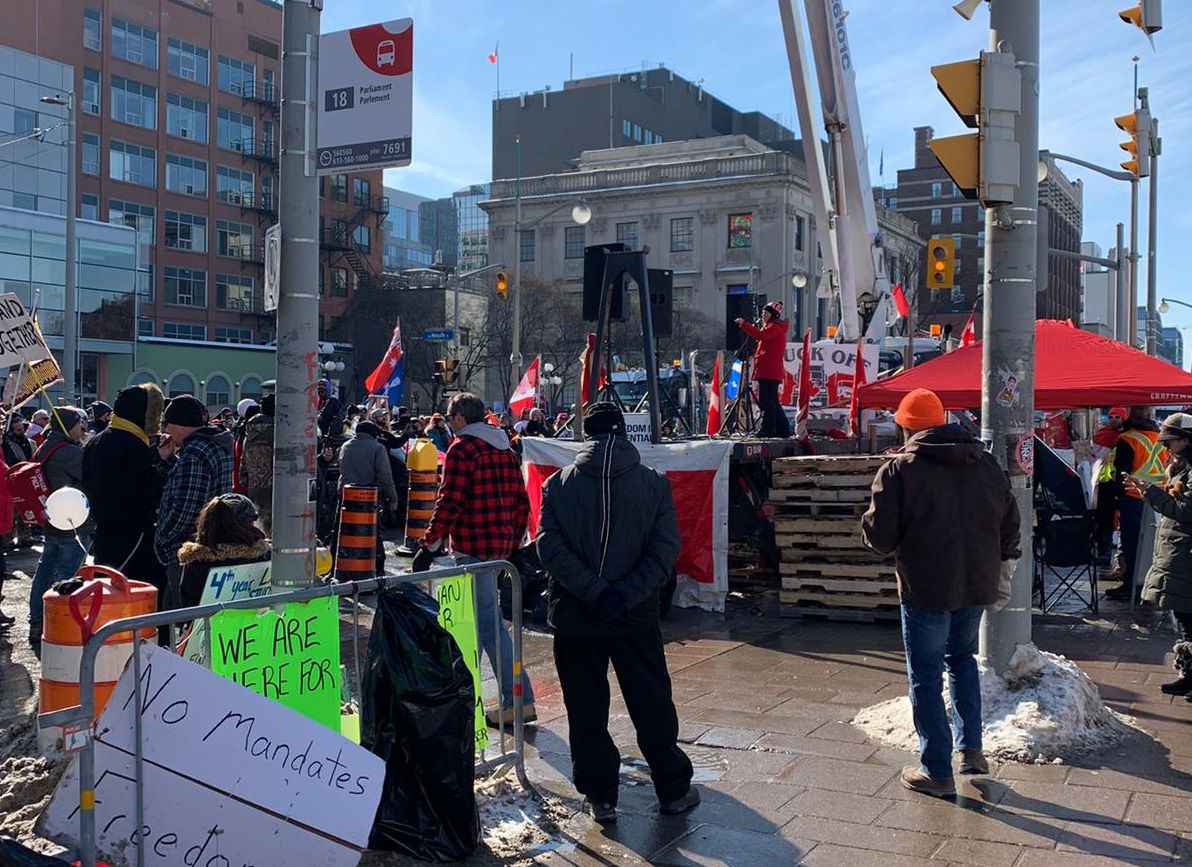 Dispatches
DispatchesLaw students from the University of Ottawa are filing dispatches for JURIST in the aftermath of the “Freedom Convoy” protests that paralyzed Canada’s capital for some three weeks and disrupted trade and cross-border traffic across the country. Here, 2L Brad Henderson reports.
Last weekend, law enforcement agencies, supported by new federal emergency rules, finally ended the illegal Freedom Convoy occupation in downtown Ottawa. As of February 20, police arrested 191 individuals and laid 389 criminal charges. While this occupation exposed significant governance weaknesses—including municipal policing failures and Canada’s fragmented and often uncoordinated federal system—it prominently displayed another very real, and often more concealed, danger to liberal democracies: disinformation (i.e., deliberately spread misinformation).
Contrary to what several politicians, commentators, and Convoy organizers wanted us to believe, the Freedom Convoy was not a grassroots movement. Its organizers capitalized on anti-vaccination and anti-COVID-19 mandate sentiment amongst a relatively small percentage of individuals to further their own political, ideological, and personal agendas, which included overthrowing the Federal Government, forcing the Prime Minister to resign, and restoring ‘unrestrained freedom’ in an increasingly complex world.
Convoy organizers consistently relied on disinformation to foster support and further their goals, all while demonstrating a significant misunderstanding of Canadian laws and governance structures—a likely effect of their distrust in fact-finding and fact-checking institutions, such as the courts and mainstream media. One organizer went so far as to claim that police “cannot touch you if you are holding a white flag,” while several other organizers consistently urged members of the protests to disobey law enforcement and continue to illegally block critical infrastructure, until those in power caved to their demands.
Some of these organizers are now facing serious criminal charges, including counselling to commit mischief, which could result in a term of imprisonment of up to ten years. They are quickly realizing that illegal acts have consequences and that the disinformation they disseminated will not serve as an effective defence in a court of law.
While the streets of Ottawa are now clear, the flow of disinformation has continued, including in relation to the Federal Government’s recent invocation of emergency legislation.
On February 14, the Federal Government—i.e., the Governor in Council—declared a public order emergency under the Emergencies Act to end the illegal occupations across Canada. This declaration allowed the Government to make orders prohibiting unlawful blockades, designating certain areas as secure zones, enabling RCMP officers to enforce municipal and provincial laws, and authorizing financial institutions to freeze funds intended to support the illegal blockades.
The Government’s invocation of such legislation provoked rigorous debate—as it should have, which included whether the blockades constituted a “public order emergency” and a “national emergency” under the Act. Yet rather than being well-informed and constructive, much of this debate domestically and abroad was embroiled in disinformation.
Parliament enacted the Emergencies Act in 1988, replacing the old War Measures Act. Contrary to what some media outlets—including widely viewed US media outlets—have claimed the Emergencies Act does not suspend civil liberties or allow the silencing of lawful protests. Orders made under the Act are subject to the Canadian Charter of Rights and Freedoms, the federal Canadian Bill of Rights, and Canada’s constitutional division of powers under the Constitution Act, 1867. Further, the Emergencies Act includes additional democratic accountability mechanisms: The Federal Government must consult with the provinces and territories before declaring an emergency, the House of Commons and the Senate must confirm the declaration within 7 sitting days, the declaration expires within 30 days unless revoked or continued, and the Government must also cause an inquiry within 60 days after the declaration’s expiry.
On Monday the House of Commons (with support from members of Parliament belonging to the Liberal Party, the NDP, and the Green Party, as well as one independent member) passed a motion affirming the Government’s declaration of a public order emergency under the Act. The Senate was set to vote on a similar motion until the Government revoked the declaration on Wednesday, claiming that the situation no longer constituted a public order emergency.
The Government’s invocation of the Act may be problematic in several respects, for example, it may set a potentially problematic precedent, and the orders or parts of those orders may unjustifiably infringe various rights and freedoms. However, what the declaration and the orders were not, was undemocratic. Canadian democracy, its accountability mechanisms, and Canada’s governing institutions remain strong: We are not subject to authoritarian rule, governments do not order arrests or influence court proceedings, and Parliament maintains the ability to revoke a declaration of an emergency or amend the Act itself.
Further, the lawfulness of the Government’s invocation of the Act and the orders made thereunder will be a question for the courts. The Canadian Civil Liberties Association has already filed an application in Federal Court for judicial review of the declaration and the orders. The Government of Alberta has also expressed its intention to challenge the declaration and the orders.
Whether the Government’s invocation of the Act was politically wise will be a question for the electorate. Yet, from a policy perspective, the emergency measures appeared effective in giving law enforcement the necessary tools to clear the Ottawa occupation. Law enforcement’s final push to clear the occupation also showed commendable restraint in avoiding violence. Narratives of ‘peaceful protests’ and ‘police brutality’ were additional example of widely disseminated disinformation, often circulated by individuals and media organizations with specific political and ideological views and objectives.
Those disseminating disinformation must understand the damage they are doing to democracies, governing institutions, and our political discourse. Selfishly promoting falsehoods hurts us all.

